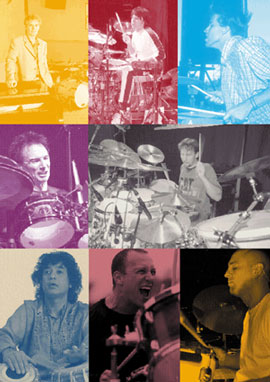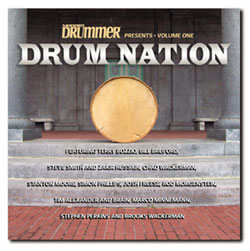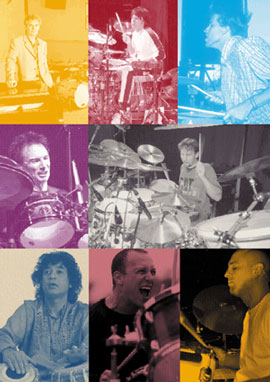Drum Nation: Top Drummers Unite On New Recording


You may have spotted the advertisement for a unique CD titled Drum Nation. It represents the music of drummers, created outside of the constraints of record labels. Terry Bozzio, Josh Freese, Bill Bruford, Steve Smith, and Stephen Perkins are just a few of the top players involved. How Drum Nation came about is an eye-opener. In fact, a non-drummer conceived of the project!
Birth Of A Nation
 You and I take it for granted, but for Magna Carta Records’ Pete Morticelli, it was a revelation: Over the years, recording band after band, drummer after drummer, Pete came to the realization that drummers are absolutely a special lot. In Pete’s eyes they were so special, so unique in their common values, that they formed a distinct community – a “drum nation.” He offers the following as evidence: “If a drummer is sick, other drummers rally to the cause. If a drummer has a problem with playing a lick, another drummer will share the correct way.
You and I take it for granted, but for Magna Carta Records’ Pete Morticelli, it was a revelation: Over the years, recording band after band, drummer after drummer, Pete came to the realization that drummers are absolutely a special lot. In Pete’s eyes they were so special, so unique in their common values, that they formed a distinct community – a “drum nation.” He offers the following as evidence: “If a drummer is sick, other drummers rally to the cause. If a drummer has a problem with playing a lick, another drummer will share the correct way.
“Ask a guitar player about another guitar player,” Pete continues, “and you get this pause. Ask a drummer about another drummer, and he’ll respond, ‘Oh, that guy’s great.’ I thought that it was time to bring some of these great players together in one place and document it.”
Advertisement
 Pete approached Modern Drummer magazine for a collaboration, and the result is a CD of drummer-led tracks. Drum Nation features a selection of talented drummers working unfettered. They obviously enjoyed the freedom to compose, write, and arrange material that might not work in other forums. They relished the free license to experiment with song form, drum sounds, and solos – and, ultimately, to have a little fun.
Pete approached Modern Drummer magazine for a collaboration, and the result is a CD of drummer-led tracks. Drum Nation features a selection of talented drummers working unfettered. They obviously enjoyed the freedom to compose, write, and arrange material that might not work in other forums. They relished the free license to experiment with song form, drum sounds, and solos – and, ultimately, to have a little fun.
This album is no mere compilation. Although the alert reader may spot a track or two on Drum Nation that has been released elsewhere, it won’t be the same version. All compositions were recorded specifically for this project. Each provides a rare look at the creative processes of the participating drummers. Let’s use Terry Bozzio’s deeply personal work as a jumping off point for an examination of several compositions that appear on Drum Nation.
Terry Bozzio
“A Glimpse Into A Deeply Disturbed Mind”
That’s the title of Terry Bozzio’s composition. Although it seemed rather obvious from the enormous sound he generates, we asked him if he used his normal kit – possibly not the best word to describe Terry’s mammoth setup. He responded with an enthusiastic, “Oh yeah!” In other words, we’re hearing the full DW kit with some forty-eight toms, a vast array of cymbals, and many extras devised by Terry. On his self-produced track, we’re also hearing Terry play keyboards, sing, and do sequencing. It all went down at the Austin School Of Music Studio, with Chet Hines behind the console and with some editing assistance from Pat Mastelotto.
Advertisement
In Terry’s words, “I felt the result was so intense and relentless that it seemed to reflect my own manic/depressive/obsessive/compulsive mental machinations, hence the title!”
Flying in the face of current trends in techno music that see an imposition of “real” music over electronically programmed drums, Terry’s goal became, in his words, “To reverse the trend. I tried to use the electronic sampled music as an accompaniment to my real drumming.”
Here’s how Terry did it: First he put together the backing track, using samples he had tweaked on his laptop. Then it was into the studio, where he recorded real drums, taking six “runs” in order to ensure all his desired parts went to Pro Tools. Next, he edited the drums into stereo loops, which were employed in various ways, as you’ll hear on the final mix. Then, says Terry, “I assembled the drums, voice, and backing track in Live (software sequencing), added the lead synth in Reason (software), then bounced it all back into Pro Tools for mixing in the studio.”
The result is a stunning barrage of sounds and drumming, united by thematic material. While reminiscent of his earlier work with Missing Persons and Zappa, the cut also pays heed to traditions in twentieth-century classical traditions and electronica.
For the recording Terry used DW drums, pedals, and hardware, Sabian Radia cymbals, Vic Firth TB Phase 1 sticks, Attack TB Signature drumheads, and Puresound beaters and snares. Microphones were courtesy of AKG, and their mounting was via the May bass drum system. Terry also uses XLSpecialty Protector cases, LP percussion, and M-Audio products.
Advertisement
Steve Smith & Zakir Hussain
“Mad Tea Time”
By now you’re thinking that this Drum Nation thing is all about calamitous mental events, what with all the talk of hell and madness. And Steve Smith’s entry into the fray is no less frantic.
When asked by Pete Morticelli to climb aboard, Smith figured that here was an opportunity to record a duet with tabla master Zakir Hussain, with whom Steve had been touring in George Brooks’ group, Summit. That was the band Steve used for the Drum Nation session.
“Mad Tea Time” is at once a complex and simple structure. Steve explains, “Rhythmically the tune is based on Indian drum compositions and various Indian rhythms. Melodically, “Mad Tea Time’ is based on the raga called Madhuvanti, which in India is often played at afternoon tea time. George and I collaborated on the writing. I brought in most of the rhythmic ideas, George [sax] composed the melody/harmony, and Fareed Haque [guitar] and Kai Eckhardt [bass] helped us flesh out the arrangement. Zakir helped it all come to life with his brilliant concept, sound, and virtuosic tabla chops.”
Advertisement
The piece features complex unison drum parts called tihais, which are rhythmic phrases repeated (stay with us!) three times resolving to “1,” and reductions such as the opening “cow’s tail,” which starts with groups of seven repeated three times. As Steve points out, it’s customary in Indian music to repeat rhythms three times in a spiralling descent: three sixes to three fives, three fours, three threes, three twos, and then ending with the tihai: “Takita dhaa,” “Takita dhaa,” “Takita dhaa.”
The recording modus operandi was traditional. “We recorded live,” explains Steve, “with no overdubs, in a studio called Prairie Sun in Cotati, California, just north of San Francisco. The drums and the band were set up in the main room, with only Zakir in a booth. We wanted to have him isolated so that the engineer could get a great tabla sound. Zakir likes to use Shure 57s on his drums. We also used Shure mic’s on the drumset, with Beta 98s clipped onto the toms, a Beta 52 on the batter side of the bass drum, an SM57 on the snare, and Shure condenser overheads. We recorded to 2″ analog tape and then transferred the music to Pro Tools for mixing. We mixed the tabla toward the left side of the stereo spectrum and the drumset more on the right side, so you can clearly hear what each of us is playing.”
Steve used his Sonor Jungle Kit, a small drumset that includes a 16″ bass drum, a 10″ rack tom, and a 13″ floor tom, to which he added a16″ floor tom. Instead of the usual Jungle snare, Steve played a 12″ Sonor Designer drum with a Remo Fiberskin head. The toms were fitted with Remo clear Ambassadors, while the bass drum got a Remo clear Emperor, muffled with a simple felt strip. The cymbals were all Zildjian: Re-Mix 12″ hi-hats, a Re-Mix 17″ ride, an 18″ K Flat Top ride, an 8″ K splash, a 9″ China splash, and a 22″ A Swish.
Advertisement
Steve added the following “scoop”: “I use ‘bundled rods’ with this setup, as opposed to sticks, because the sound blends well with the tablas without being overpowering. I’ve also been experimenting with the technique of pitch bending on my drums, simulating the pitch bending of the baya’the left tabla drum. In this piece I used the left beater of my double pedal to alter the pitch of my bass drum in a couple of places.”


